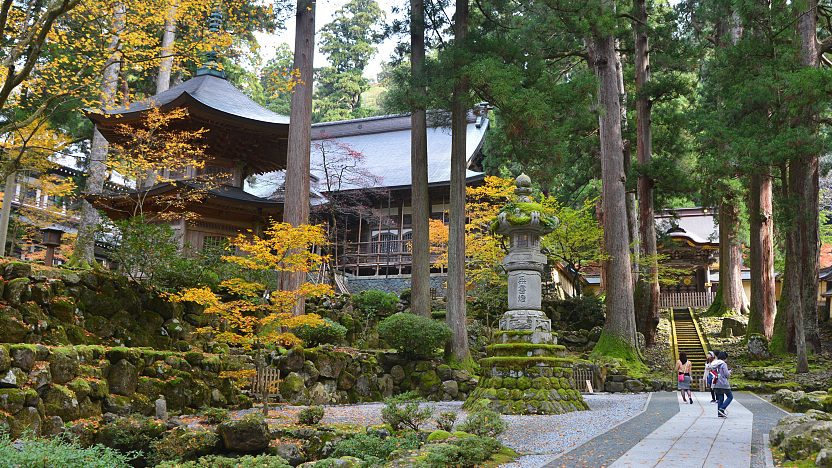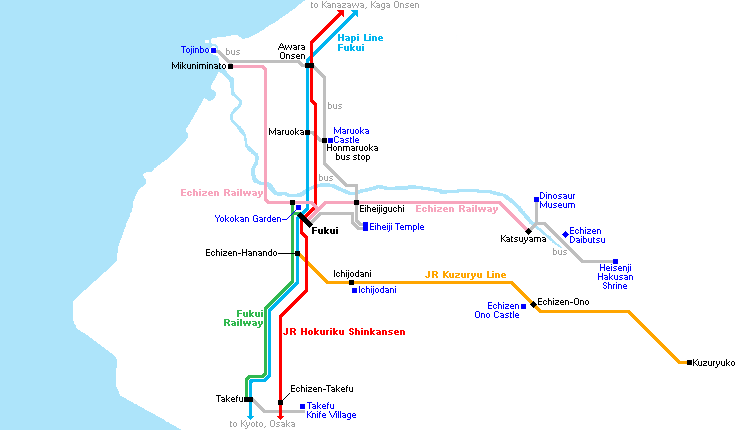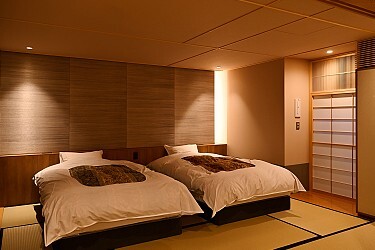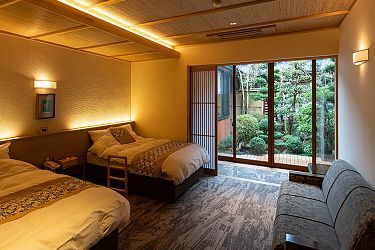
Eiheiji (永平寺) is a large temple complex and active monastery standing on a cedar-covered slope in the mountains just outside Fukui City. The temple was founded in 1244 by Dogen, the Buddhist scholar who introduced Soto Zen from China to Japan in 1228. Eiheiji is one of two head temples of the Soto Sect of Zen Buddhism (the other was formerly Sojiji Temple on the Noto Peninsula before its head functions were transferred to Yokohama).
The sizable temple complex consists of over 70 buildings, which are connected to each other by covered walkways that protect from the heavy snow seen in the region from December to March. The warmer months bring lush vegetation to the temple grounds, which are especially beautiful from late October to early November when the autumn colors typically peak.

Visitors enter Eiheiji through the reception hall (Kichijokaku), a modern temple building for laypeople, with its own kitchen, bath, sleeping quarters, study rooms and a large meditation hall adorned by a beautifully decorated, coffered ceiling. Visitors first receive a short orientation about the temple in Japanese before they can explore the temple grounds on their own. Good foreign language pamphlets are available that describe the various buildings.
Covered walkways lead from the reception hall to the temple's more historically significant buildings including the Sanmon Gate, which was rebuilt in 1749 and is the oldest standing building on the grounds today; the Buddha Hall (Butsuden) at the center of the complex, which houses statues of the past, present and future Buddha; the spacious main lecture hall (Hatto) at the top of the slope; and the founder's hall (Joyoden), which contains the ashes of Dogen and images of Eiheiji's successive head monks.
A few other significant buildings can only be viewed from the outside, including the monks' quarters (Sodo), where the monks eat, sleep and meditate; the kitchen (Daikuin) where the meals for the monks are prepared; and the baths and toilets (Yokushitsu and Tosu), as bathing is an important cleansing ritual in Soto Zen Buddhism. In addition, a beautiful belfry can be seen below the Sanmon Gate, holding a giant bronze bell which is rung four times per day.

Getting there and around
There are hourly direct buses between Fukui Station and Eiheiji, taking 30 minutes and costing 750 yen one way. Alternatively, there are two connections per hour by the Echizen Railway from Fukui Station to Eiheiji-guchi Station (25 minutes, 460 yen one way), where you can transfer to a bus to Eiheiji (15 minutes, 430 yen).
Those approaching Fukui from the north (e.g. from Kanazawa or Kaga Onsen) can consider getting off the train at Awara Onsen (one stop before Fukui by limited express train) and transfer to a bus to Eiheiji (60 minutes, 1150 yen, every 2 hours).
How to get to and around Fukui

Hours and Fees
Hours
Closed
Admission
Questions? Ask in our forum.
Links and Resources
Hotels around Fukui
-
-
![]() Kofuyuden BeniyaAn elegant, historical ryokan since Meiji Era in Awara Onsen Fukui. 17 luxurious Japanese rooms. Each room has a private hot spring bath. Fully rebuilt in 2021.View siteSponsored
Kofuyuden BeniyaAn elegant, historical ryokan since Meiji Era in Awara Onsen Fukui. 17 luxurious Japanese rooms. Each room has a private hot spring bath. Fully rebuilt in 2021.View siteSponsored -
![]() Haiya RyokanA historical onsen ryokan with thoughtful hospitality. Established in Meiji Era. Spacious rooms & beautiful garden await your arrival. Free pick-up available.View siteSponsored
Haiya RyokanA historical onsen ryokan with thoughtful hospitality. Established in Meiji Era. Spacious rooms & beautiful garden await your arrival. Free pick-up available.View siteSponsored
-




